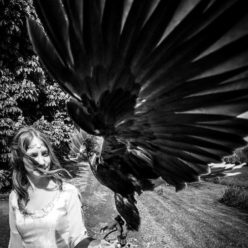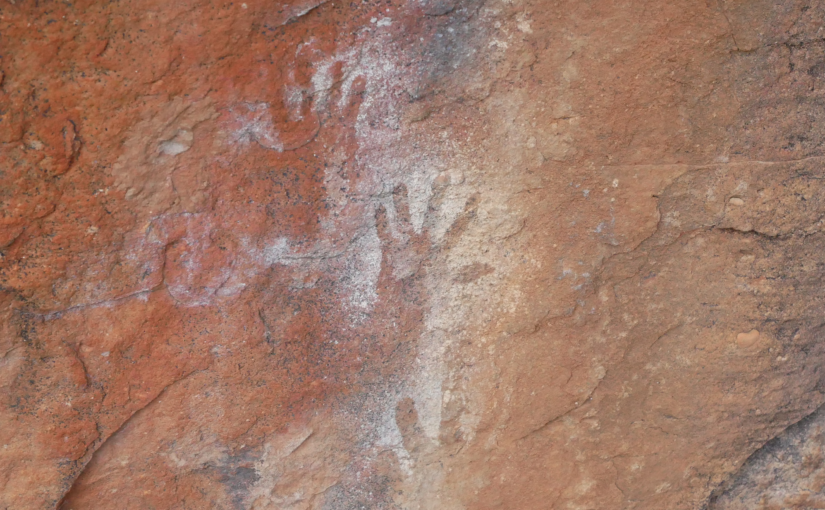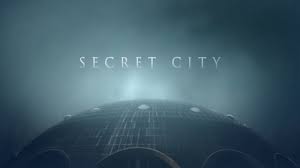Mounts Grenfell and Gunderbooka, then Bourke to Brewarrina. Moving through me even now.
Now, the next day’s drive was an Adventure; a real Adventure, which is what you tell the Gentleman when it seems you fucked up the Google map he emailed you by poking it and moving the checkpoints and now you’ve driven 2 hours out of your way into – not the bush – but a bush; but he took it all in his stride famously.
Our next night stay was at Cobar (follow the only road out of Mungo, turn left, then turn right, keep bloody going) with a stop at Mount Grenfell. This is another significant Aboriginal site with ancient rock art and there was also the option of a little 5km walk around the hill on which I was Dead Keen. We left Mungo reluctantly on a splendid golden morning and got back on the old red road. Drove nearly two hours through more of the Willandra lakes, waving at emus and red kangaroos (let them know we’re friendly) through a land unflinchingly green. We came to see the desert and were overwhelmed by flowers; yellow, white, purple, magenta, pink, and grass; real, soft, good sitting grass, spreading out like parkland. The sky was wide and blue enough to drown in giving a sense of vertigo, like being upside down or underwater. We saw a dust devil, about the size of a tall handsome man; it gathered up, whipped across the road ahead of us with its red right hand, and dispersed. We listened to hillbilly local radio where the interviewee actually said, ‘we look back very fondly at those moments of real humiliation in our childhood;’ and something about making a bikini out of a curtain, like some sort of shit 60s Scarlett O’Hara. Well now, weren’t things better in the old days! When the first anti-vaxxer called in, we cheered. Then here’s about where our little Adventure started when the map directed us off the unsealed red road through the trees onto what …. may have been a footpath?; dodging bushes and logs until we got to a locked gate. Grass up to your knees. Felt like going for a stroll in Leaden Rhoding. Or when Raffa lurches you off the main road in Capriglio to the veg garden in the woods. We made it back to the road. In silence.
This all meant that by the time we got to Mount Grenfell, there was no time for a walk. But it was sunny, and blood red with soft trees and breezes and we clambered the short walk to the site over wide soft grey rocks. Eucalyptus trees were in blossom, there was a hum of bees and cries of butcherbirds and just… a gentleness, after the overwhelming spaces of Mungo. The art was incredible. Alright, look, I’m into the Renaissance, so yeah, it’s pretty simplistic; it’s red, yellow and white ochre on a fucken rock, so gauge your expectations. But there were nifty little emus and kangaroos which were cool. And my favourite; stencils of hands. Apparently these are ceremonial. I don’t know what of, or what for, but that was amazing to see and think: a man stood here, right where I am, and put his hand there. And because it’s not a print, it’s a stencil, an absence of space, something prompts it to be filled, reaches out and invites you to put your hand there and reach across thousands of years and know with something deeper than just your mind, that a man stood there, like you, before.
Right, but don’t actually fucken touch them because they’re thousands of years old, ok, and if it’s ceremonial then ‘reaching out across aeons’ may well miss the point and there’s a barrier in front anyway. Whatever. It was beautiful there and I wanted to stay, and maybe if I wasn’t such a clumtard with the internet, we could have. And so we drove on, cooing over feral goats and kids (who knew?), and the Gentleman made profound comments about it being nice to actually see some of the stuff that just gets talked about a lot in Canberra. You have to stamp through the surface of Colonialism, he said. I liked that metaphor. It reminded me of my feelings when we first arrived about floating on top of Australia, on a veneer, unattached. We arrived in Cobar, ate a Country Thai (or if going by the colloquial ‘Choinese,’ this equivalated to a ‘Thoi’), read some Pratchett and went to bed.
The next stop was Bourke. The plan was to get there by midday so we could GET A RIDE ON THE BOAT!! which left at 14.30. On the way, we skidded round to Mount Gunderbooka for more rock art. Apparently this ‘mount’ is known as a bit of a mini Uluru; a big fucken rock in the middle of a wide open plain. I can assure you we checked our map very carefully this time. The drive was beautiful, the road was moist red, there were emus running around everywhere – one nearly right into the windscreen, stupid bloody thing – and I kept stopping to take pictures of flowers because I didn’t think anyone would believe me about them if I didn’t. While Grenfell was made of soft and dreamlike greys, Gunderbooka was red and brown; its rocks stacked high in columns and terraces. Great for playing and hiding. There were glorious views of blue hills, blue sky, and lots of shade from butcherbird-decorated trees and lovely fragrant wattle startlingly golden against the reds and blues. The Gentleman said this was his favourite. He could imagine people here, the camp. Here was the beautiful stream, for water, food, for children to play in; here was a soft flowered grassy terrace above it, shaded with trees where a fire could be made and food eaten, and the rocks like the wall of a hall sheltering them, ornamented by art. We drove back along the soft red road admiring birds and flowers, and turning back, we could see how marvellously the mountain stood out. Fucking awesome.
We arrived at Bourke and hopped on the paddleboat Jendra down the Darling. That was pretty great! We had a beer, took pictures of bridges, pelicans and trees and the captain gave a charming commentary which was full occa and worth every penny. Then…well. Bourke was a bit weird. It has a drive-through bottle-o (*English translation: off licence), who thought that was a good idea? a wooden wharf over the Darling and an English steam engine they turn on at midday. That was about it. We did the Bourke Tour of Historic Buildings. Took about ten minutes, and we got a lot of weird looks. Particularly from the guy lingering outside the Court while we tried to photograph it. There were 2 pubs and we had lunch in one and dinner in the other. The latter was a large tin room with a canteen sort of feel to it adjoining an older pub that also seemed to have a bit of an atmosphere vacuum. I suggested getting smashed and leaning in to it. The Gentleman declared firmly that we were leaving, so finish your bloody dinner.
We left Bourke somewhat thankfully the following morning, and to my emphatic delight, discovered our route on to Lightning Ridge would take us through Brewarrina and the ancient Aboriginal fish traps. Being a Woke Canberran, I’ve read all about these in Bruce Pascoe’s seminal The Dark Emu, which I recommend because it is a fascinating enlightenment about the world’s oldest continuing culture. Anyway, we arrived, and a local Elder gave us a tour which was both moving and enlightening. I now understand emotionally the things I’ve read in books. But one of the most beautiful things that Bradley elaborated on (beyond horrific local massacres, segregations, missions separating families and environmental destruction) was that his people belong to the river. They don’t own it. He had a nifty way of repeating himself that was either trying to remember where he was up to or deeply effective subliminal messaging. But belonging to the land, not owning it, just seems to me to encapsulate respect, equality, productivity, and love. Surely this is what Planet A should strive for. And maybe it was the atmosphere combined with the stories, and a lovely day, but the river seemed to be absolutely teeming; frothing; heaving, with life, with animals, and movement. I could understand how it is identity and blood for this group of people. So, Bradley doesn’t watch the telly. But he tells it like it is, hard to hear or otherwise. In one tour, after he’d talked about the ignorance of governments not knowing the historical law they themselves had implemented that gave Aboriginals exemption during WWII to move to the other side of the Barwon river for work, but did not let them cross back again to return to their families; his friend called him up and asked if he’d seen Twitter. No, he said. And there on Twitter, was a picture of Bradley stood next to ScoMo, after he’d told him all this. (English translation: the Prime Minister of Australia). And one of him with the NSW Premier, too. He had no idea who these people were, and if he did, I don’t think he would have held back.
Anywho, these fish traps are the oldest human construction on the planet and archaeologists are arguing between them being 50,000 to 70,000 years old. Right on, Australia. They were beautiful. They’re moving through me, even now.
We got on the road and cranked up Nick Cave.


